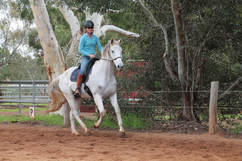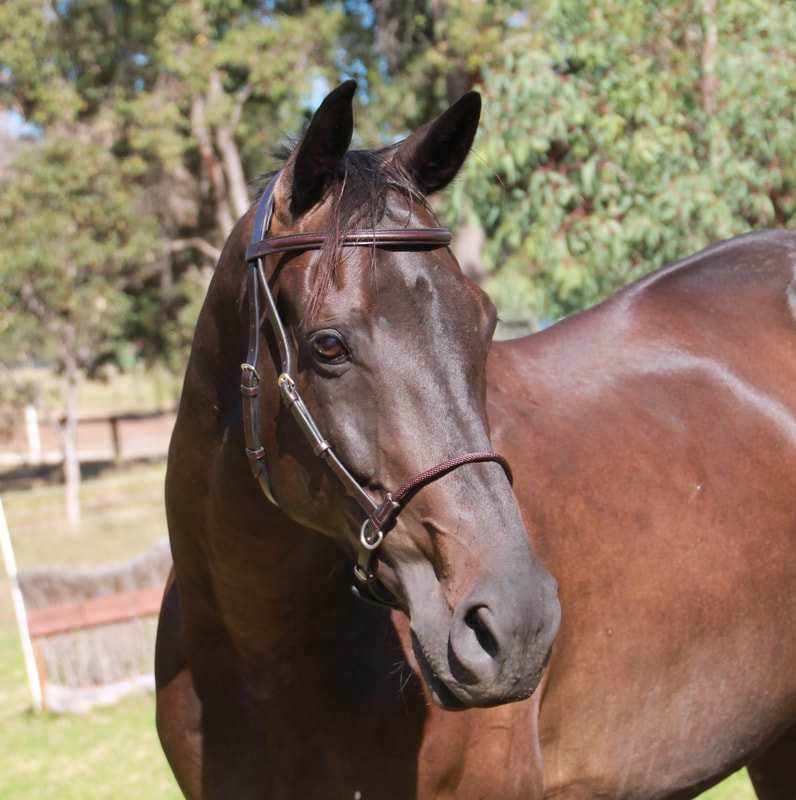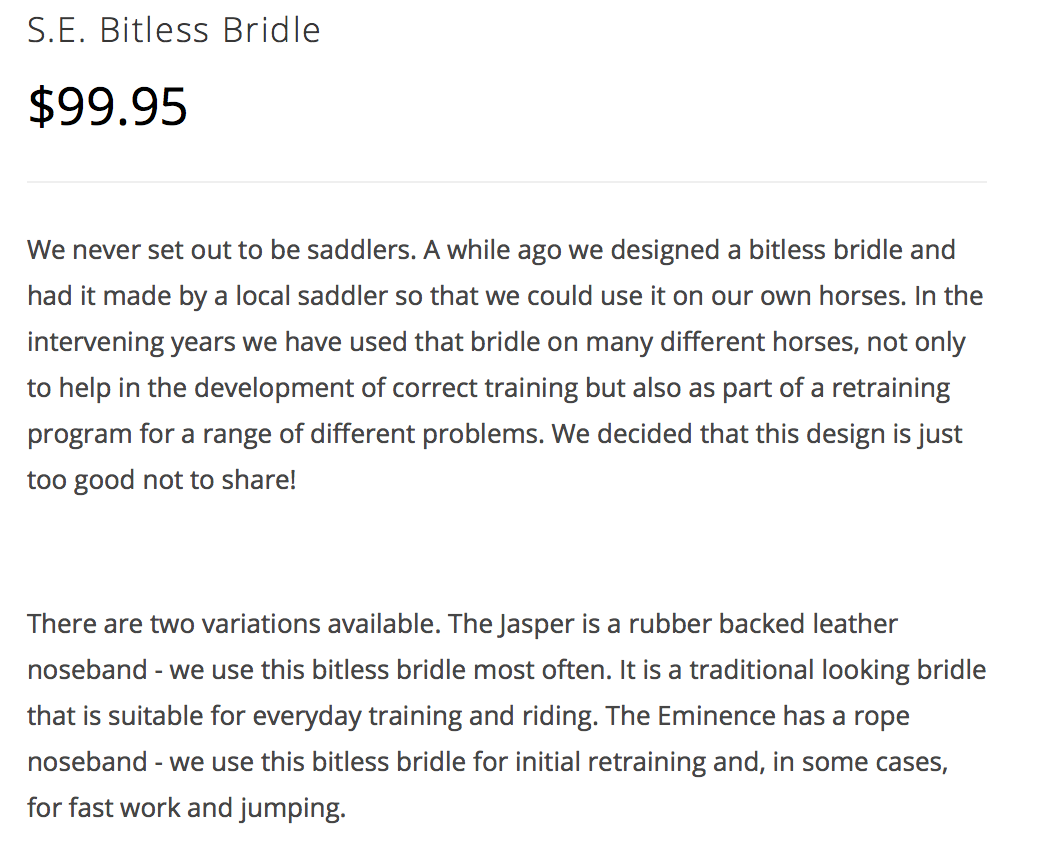
We really like our bitless bridles and use them for many reasons. They can help improve calmness, jumping technique and self carriage. They are great for riders that can’t stop fiddling with the reins and they teach us a great deal about how each individual horse likes to carry his head in order to have the best vision. But mostly we use our bitless bridles because they provide a training task that is different to everyday and because it’s great fun to ride bitless. Read part one of our going bitless articles here.
We use our own design of bitless bridle because they are simple, there is no time delay between the release of the aid and the release of the pressure, and it’s very compatible with the aids that we train during groundwork. Basically, our bridle is a cavesson noseband with reins attached to the side. We have always found it to be simple and the transition from bit to bitless is really quite straightforward. You can purchase a Sustainable Equitation Bitless Bridle here.
We use our own design of bitless bridle because they are simple, there is no time delay between the release of the aid and the release of the pressure, and it’s very compatible with the aids that we train during groundwork. Basically, our bridle is a cavesson noseband with reins attached to the side. We have always found it to be simple and the transition from bit to bitless is really quite straightforward. You can purchase a Sustainable Equitation Bitless Bridle here.

Before we use a bitless bridle for the first time we always make sure the horse’s responses in hand are light and immediate. The horse should be able to step back from a light pressure of the lead rope. There are as many ways of doing groundwork, but when preparing to ride bitless it is important that the horse will stop lightly and step back from pressure on the noseband of the halter – because this is the response we will use under saddle. (Light pressure is no more than a 2/10 pressure if 0 is no pressure at all and 10 is as much pressure as you can apply.) We always make sure we can do downward transitions from trot to halt in hand with our horses using only light pressure on the lead rope before we decide to go bitless for the first time.
Once our horse can do light downward transitions in hand we usually ride for the first time in a small, enclosed space like a round yard. Once again, we focus on achieving light downward transitions. We will quite often start this process with one person in the saddle and one person on the ground. That way, we only practice the right thing. This is a bit of an obsession of ours… people often say that it is important to finish a session on a good note, but we think it’s more important not to argue in the first place. If you train carefully, obsess about having light, clear responses and increase the difficulty in teeny tiny increments, then the horse will usually cope with the more difficult work without any stress. I think good trainers are often very conservative with their demands but generous with their rewards.
Once we can do light downward transitions in a small space we head out into the dressage arena. We always start out slow, doing lots of walk/halt transitions and ensuring they’re light before trying a trot. When we can do a trot/halt transition from a light pressure we will try the canter. We just build up the difficulty gradually, a little bit each day. We quite often use cones or blocks to mark out a square and ride the horse around that. This gives us a good idea of how accurate we can make the horse and gives us a guide for training the turn response.
When we are happy that the horse is safe, calm and responsive at walk, trot and canter on the dressage arena we will venture out and try other places. If we are not sure that our training is adequate, we keep training until it is. Occasionally, with horses that have a history of running off after a jump or rushing on the approach to a fence, we will use a combination of our bitless bridle with the horse’s usual bridle underneath – with reins attached to both. It takes a bit of juggling to manage both sets of reins but having the bit there as a back up is a more conservative approach that can help the rider during the transition from bit to bitless.
Once our horse can do light downward transitions in hand we usually ride for the first time in a small, enclosed space like a round yard. Once again, we focus on achieving light downward transitions. We will quite often start this process with one person in the saddle and one person on the ground. That way, we only practice the right thing. This is a bit of an obsession of ours… people often say that it is important to finish a session on a good note, but we think it’s more important not to argue in the first place. If you train carefully, obsess about having light, clear responses and increase the difficulty in teeny tiny increments, then the horse will usually cope with the more difficult work without any stress. I think good trainers are often very conservative with their demands but generous with their rewards.
Once we can do light downward transitions in a small space we head out into the dressage arena. We always start out slow, doing lots of walk/halt transitions and ensuring they’re light before trying a trot. When we can do a trot/halt transition from a light pressure we will try the canter. We just build up the difficulty gradually, a little bit each day. We quite often use cones or blocks to mark out a square and ride the horse around that. This gives us a good idea of how accurate we can make the horse and gives us a guide for training the turn response.
When we are happy that the horse is safe, calm and responsive at walk, trot and canter on the dressage arena we will venture out and try other places. If we are not sure that our training is adequate, we keep training until it is. Occasionally, with horses that have a history of running off after a jump or rushing on the approach to a fence, we will use a combination of our bitless bridle with the horse’s usual bridle underneath – with reins attached to both. It takes a bit of juggling to manage both sets of reins but having the bit there as a back up is a more conservative approach that can help the rider during the transition from bit to bitless.




 RSS Feed
RSS Feed
